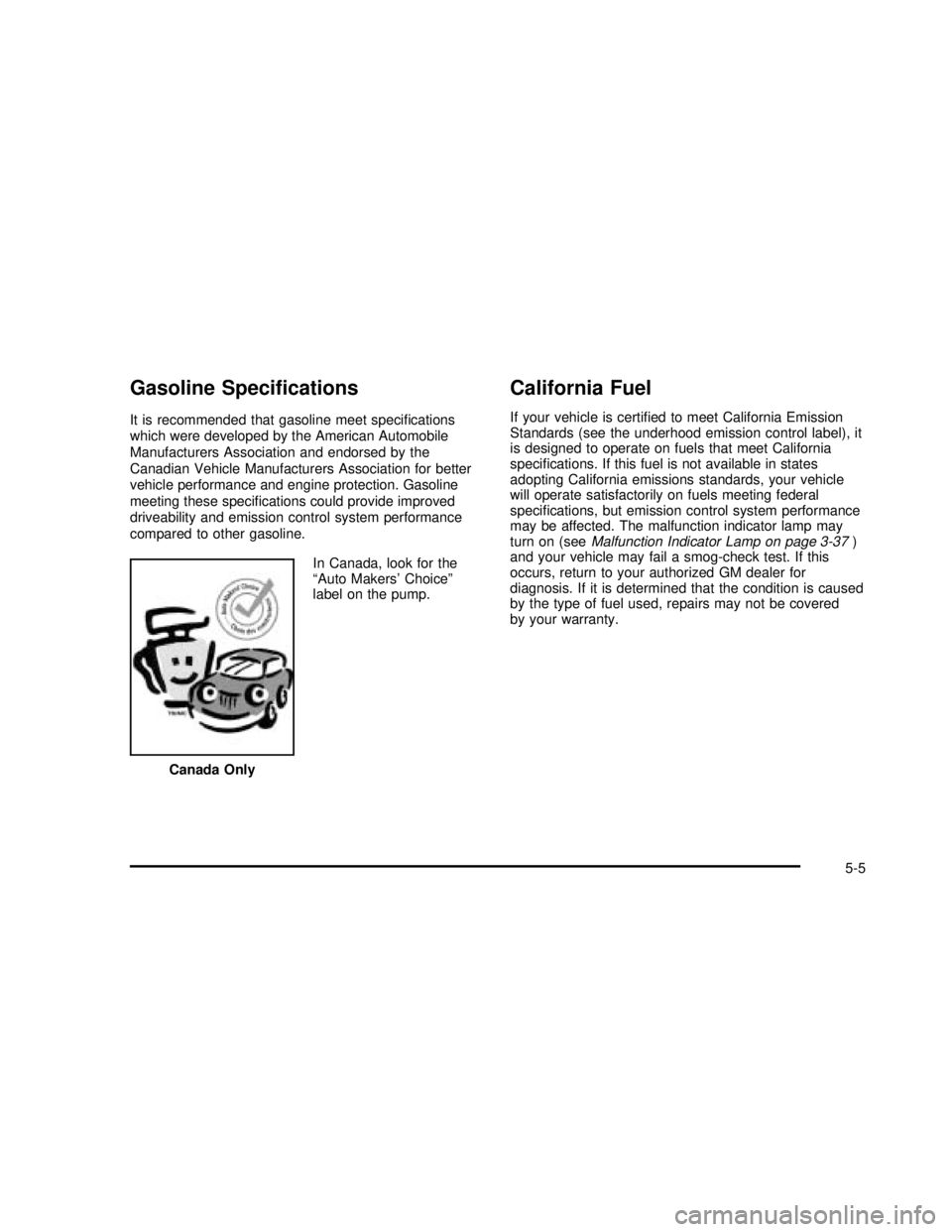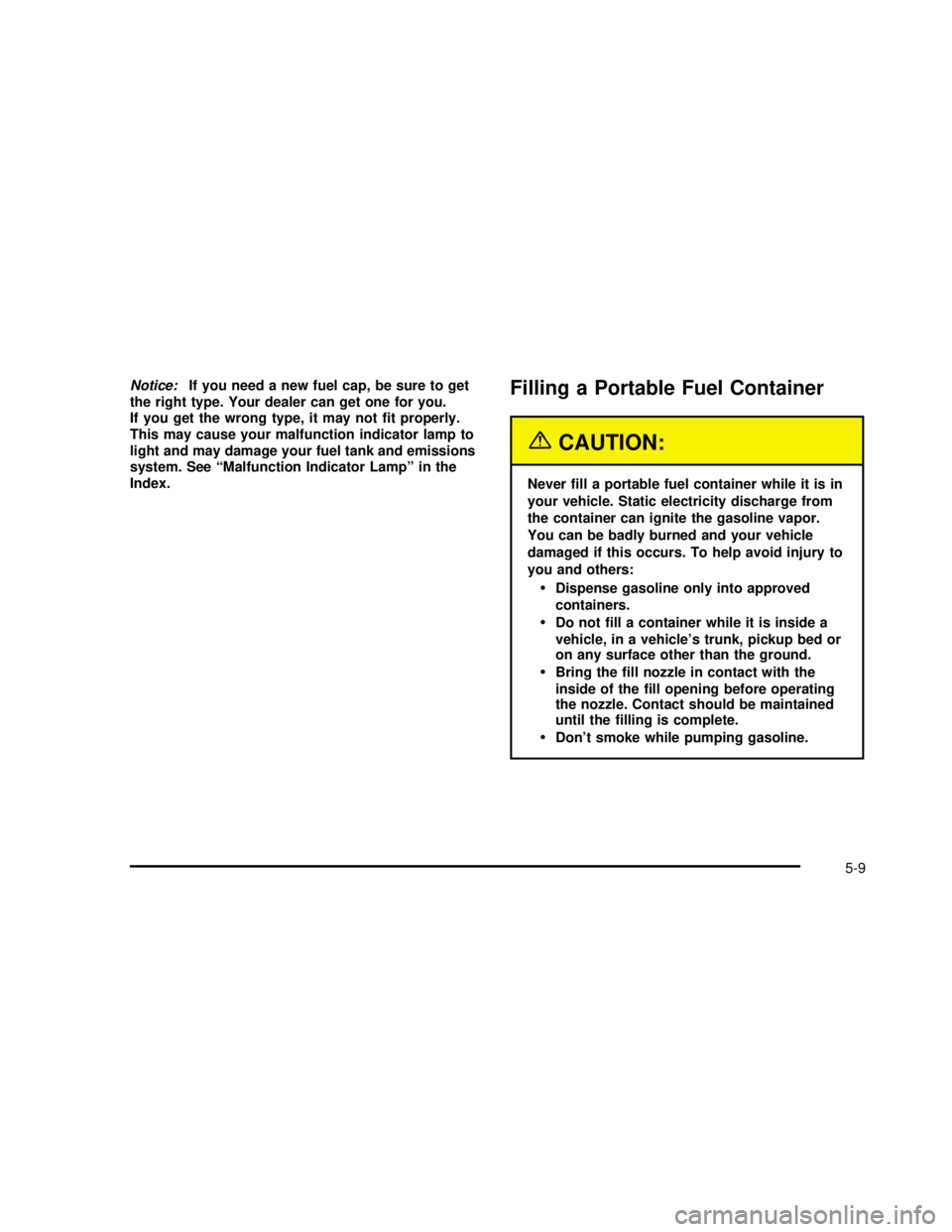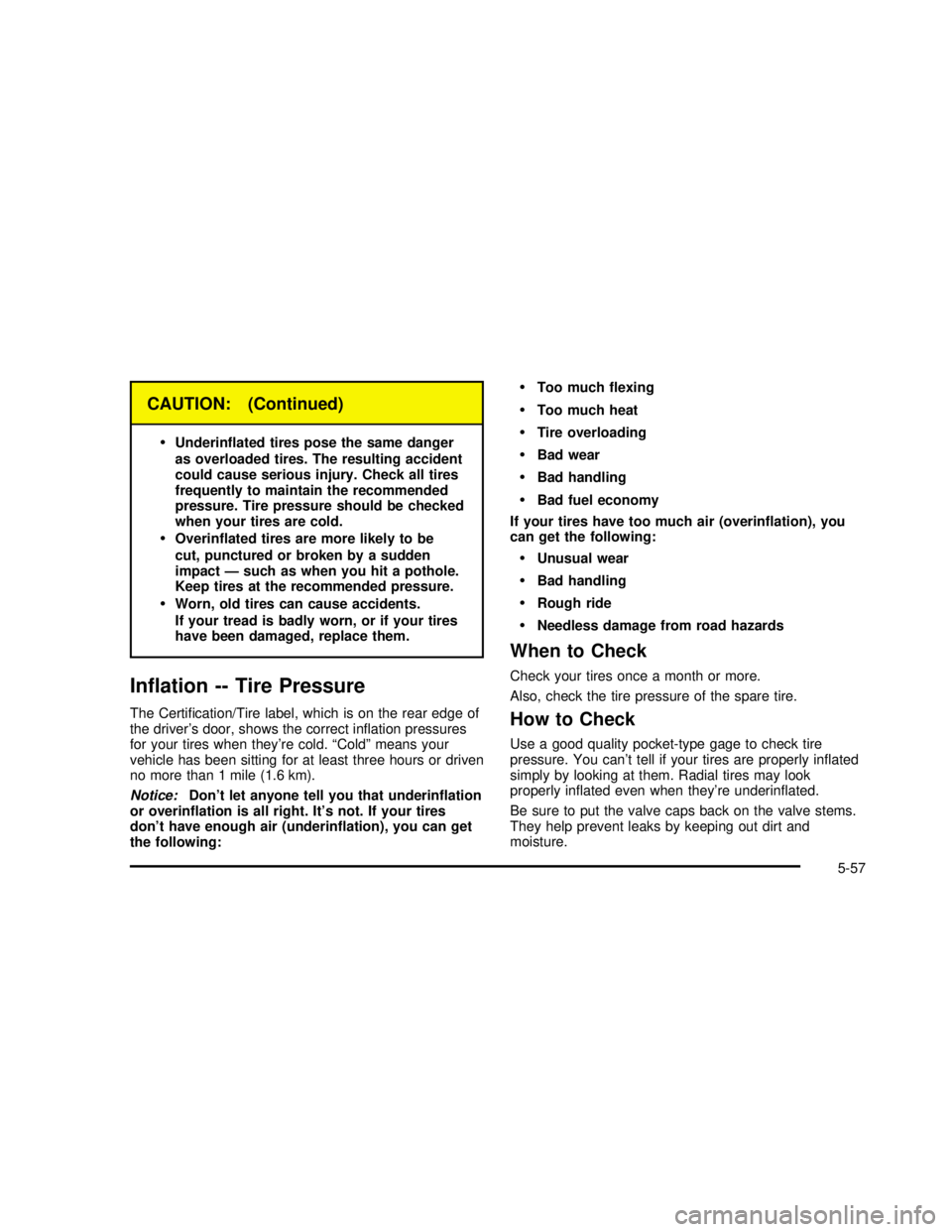fuel type GMC SIERRA 2003 Owner's Manual
[x] Cancel search | Manufacturer: GMC, Model Year: 2003, Model line: SIERRA, Model: GMC SIERRA 2003Pages: 408, PDF Size: 2.58 MB
Page 245 of 408

Recreational Vehicle Towing
Recreational vehicle towing means towing your vehicle
behind another vehicle—such as behind a motorhome.
The two most common types of recreational vehicle
towing are known as“dinghy towing”(towing your
vehicle with all four wheels on the ground) and“dolly
towing”(towing your vehicle with two wheels on
the ground and two wheels up on a device known as
a“dolly”).
Your vehicle was not designed to be towed with any of
its wheels on the ground. If your vehicle must be
towed, seeTowing Your Vehicle on page 4-46.
Notice:Towing an all-wheel-drive vehicle with all
four wheels on the ground, or even with only two of
its wheels on the ground, will damage drivetrain
components. Don’t tow an all-wheel-drive vehicle if
any of its wheels will be on the ground.
Loading Your Vehicle
The Certi�cation/Tire label is found on the rear edge of
the driver’s door.
The label shows the size of your original tires and the
in�ation pressures needed to obtain the gross weight
capacity of your vehicle. This is called the GVWR (Gross
Vehicle Weight Rating). The GVWR includes the
weight of the vehicle, all occupants, fuel and cargo.
4-47
2003 - Sierra Denali
Page 265 of 408

Gasoline Specifications
It is recommended that gasoline meet specifications
which were developed by the American Automobile
Manufacturers Association and endorsed by the
Canadian Vehicle Manufacturers Association for better
vehicle performance and engine protection. Gasoline
meeting these specifications could provide improved
driveability and emission control system performance
compared to other gasoline.
In Canada, look for the
“Auto Makers’Choice”
label on the pump.
California Fuel
If your vehicle is certified to meet California Emission
Standards (see the underhood emission control label), it
is designed to operate on fuels that meet California
specifications. If this fuel is not available in states
adopting California emissions standards, your vehicle
will operate satisfactorily on fuels meeting federal
specifications, but emission control system performance
may be affected. The malfunction indicator lamp may
turn on (seeMalfunction Indicator Lamp on page 3-37)
and your vehicle may fail a smog-check test. If this
occurs, return to your authorized GM dealer for
diagnosis. If it is determined that the condition is caused
by the type of fuel used, repairs may not be covered
by your warranty.
Canada Only
5-5
2003 - Sierra Denali
Page 269 of 408

Notice:If you need a new fuel cap, be sure to get
the right type. Your dealer can get one for you.
If you get the wrong type, it may notfit properly.
This may cause your malfunction indicator lamp to
light and may damage your fuel tank and emissions
system. See“Malfunction Indicator Lamp”in the
Index.Filling a Portable Fuel Container
{CAUTION:
Neverfill a portable fuel container while it is in
your vehicle. Static electricity discharge from
the container can ignite the gasoline vapor.
You can be badly burned and your vehicle
damaged if this occurs. To help avoid injury to
you and others:
•Dispense gasoline only into approved
containers.
•Do notfill a container while it is inside a
vehicle, in a vehicle’s trunk, pickup bed or
on any surface other than the ground.
•Bring thefill nozzle in contact with the
inside of thefill opening before operating
the nozzle. Contact should be maintained
until thefilling is complete.
•Don’t smoke while pumping gasoline.
5-9
2003 - Sierra Denali
Page 317 of 408

CAUTION: (Continued)
•
Underinflated tires pose the same danger
as overloaded tires. The resulting accident
could cause serious injury. Check all tires
frequently to maintain the recommended
pressure. Tire pressure should be checked
when your tires are cold.
•Overinflated tires are more likely to be
cut, punctured or broken by a sudden
impact—such as when you hit a pothole.
Keep tires at the recommended pressure.
•Worn, old tires can cause accidents.
If your tread is badly worn, or if your tires
have been damaged, replace them.
Inflation -- Tire Pressure
The Certification/Tire label, which is on the rear edge of
the driver’s door, shows the correct inflation pressures
for your tires when they’re cold.“Cold”means your
vehicle has been sitting for at least three hours or driven
no more than 1 mile (1.6 km).
Notice:Don’t let anyone tell you that underinflation
or overinflation is all right. It’s not. If your tires
don’t have enough air (underinflation), you can get
the following:
•Too muchflexing
•Too much heat
•Tire overloading
•Bad wear
•Bad handling
•Bad fuel economy
If your tires have too much air (overinflation), you
can get the following:
•Unusual wear
•Bad handling
•Rough ride
•Needless damage from road hazards
When to Check
Check your tires once a month or more.
Also, check the tire pressure of the spare tire.
How to Check
Use a good quality pocket-type gage to check tire
pressure. You can’t tell if your tires are properly inflated
simply by looking at them. Radial tires may look
properly inflated even when they’re underinflated.
Be sure to put the valve caps back on the valve stems.
They help prevent leaks by keeping out dirt and
moisture.
5-57
2003 - Sierra Denali
Page 360 of 408

Engine Specifications
Engine VIN Code Type Spark Plug Gap
VORTEC™6000 U V8 0.060 inches (1.52 mm)
Wheels and Tires
Wheel Nut Torque 140 lb ft (190Y)
Tire Pressure See the Certification/Tire label on the rear edge of the
driver’s door.
Normal Maintenance
Replacement Parts
Part Number
Oil Filter*PF44
Engine Air Cleaner/Filter* A1518C
Passenger Compartment Air Filter Kit** 52485513
PCV Valve*CV2001–C
Spark Plugs41–974*/PZTR5A15 NGK
Fuel Filter*GF626
Wiper Blades**15153642
TypeITTA
*ACDelco
®Part No.
**GM Part No.
5-100
2003 - Sierra Denali